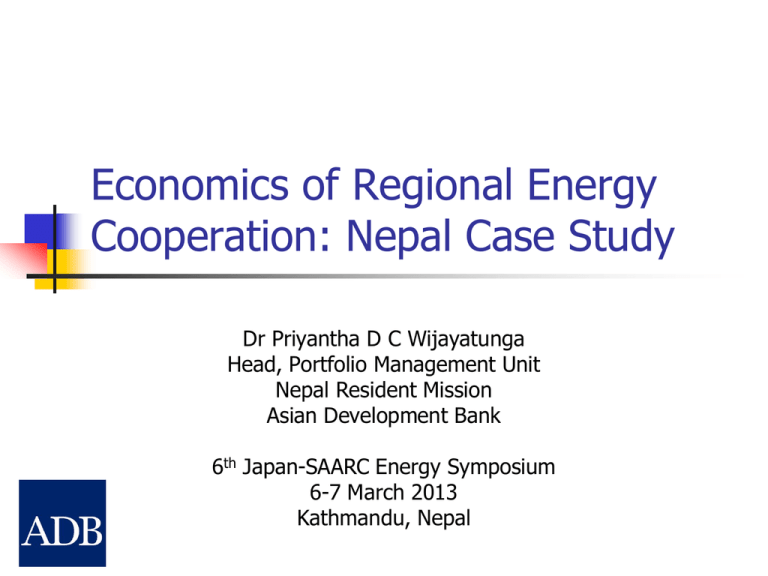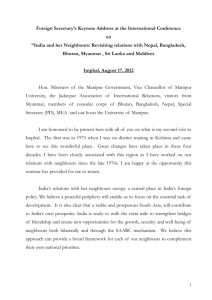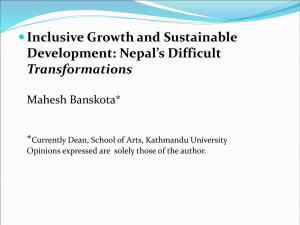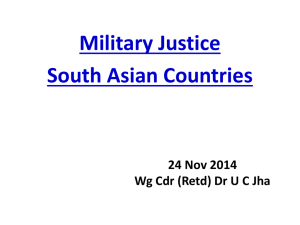Regional Cooperation in Energy: SAARC
advertisement

Economics of Regional Energy Cooperation: Nepal Case Study Dr Priyantha D C Wijayatunga Head, Portfolio Management Unit Nepal Resident Mission Asian Development Bank 6th Japan-SAARC Energy Symposium 6-7 March 2013 Kathmandu, Nepal Outline Need for Regional Cooperation Regional Energy Trade Study India-Nepal Interconnections Economic benefits Final Remarks 2 Regional cooperation? Wide variation in resource endowments Full potential not exploited Economic opportunities energy exporting countries Enhanced opportunities for climate change mitigation Single fuel dominance Hydropower, coal, natural gas and other renewable energies Sharing of low cost energy resources Energy resource diversification and energy security Acute power shortages 3 Sri Lanka 0% Pakistan 20% Nepal 40% Maldives 60% India 80% Bhutan 100% 120% Bangladesh Traditional Fuel Use Afghanistan Sri Lanka Nepal India Bhutan Bangladesh Contribution of Traditional Fuels Energy Sector Energy Access 100% 80% 60% 40% 20% 0% 4 Energy Sector …. Generation Composition Demand Supply Gap 100% 80% 60% 40.00% 40% 20% India Gas Sri Lanka Liquid Pet Nepal Hydro Bhutan Sri Lanka Pakistan Nepal Maldives India Bhutan 0.00% Bangladesh 0% 20.00% Bangladesh Demand Supply Gap (%) 60.00% Coal Other 5 Energy Sector …. Per Capita Resources 200.00 160.00 120.00 80.00 40.00 Sri Lanka Nepal India Bhutan Bangladesh 0.00 Electricity Supplies • Region to add about 63000MW of coal power (2012-2017) • Will generate about 410 TWh per year – About 390 million CO2 emissions Hydropower (GW per 100 persons) Coal (tons per person) Gas (tcf per 100 persons) 6 Short distances to connect 7 SAARC Regional Energy Trade Study (SRETS) Proposed projects India-Nepal power interconnections Dhalkebar to Muzaffarpur Gorakhpur to Butwal Bangladesh-India power interconnection Western border of Bangladesh Assist Bangladesh to import power from India Bhutan-India interconnections Catering increased hydropower development and crossborder trade India-Sri Lanka interconnection Establishment of a regional power market 8 Proposed interconnections 9 10 India-Nepal interconnections 11 India-Nepal Electricity Trade 700 500 400 300 200 100 Import from India 2011 2010 2009 2008 2007 2006 2005 2004 0 2003 Electricity (GWh) 600 Export to India 12 Economic Benefits Benefits of regional cooperation Dhalkebar-Muzaffarpur transmission line Analysis carried out with an investment planning model Reduced integrated South Asia transmission network of 40 nodes and 166 transmission lines “with” and “without” project scenarios. 13 Methodology Power transfer analysis based on load flow model of India-BhutanBangladesh-Sri Lanka (>3200 buses) Equivalent network NATGRID optimisation with DC approx. to load flow using equiv network (40 nodes, 166 lines) Scenarios NATGRID run without interconnector NATGRID run with interconnector Comparison of scenarios Benefit = Difference in cost without and with link 14 Economic Benefits ….. Generation investments Based on generation plans of the individual countries Transmission capacity and electricity demand projections Based on the national plans Extrapolated in certain cases 15 Economic Benefits ….. Benefit of cross-border transmission measured Reduced generation costs both investment and operation Reduced cost of unserved energy Due to increased overall effective generation capacity at the disposal of each of the countries. 16 Economic Benefits ….. Project estimated to cost $186 million The study analysed inclusive of in-country transmission network strengthening to support 1000MW of cross-border flows Nepal reaching a generation surplus state by 2016/17 Nepal remains a deficit state even by then Accrued benefits $ 105-215 million per year Cost of the transmission around $ 20 per year Interconnector highly beneficial in both scenarios Benefits far higher in the latter 17 Final remarks Economic rationale for India-Nepal interconnections is high High energy transfers Significant difference in economic costs Additional benefits Climate change mitigation Improved reliability 18 Thank you Priyantha D C Wijayatunga E-mail: pwijayatunga@adb.org 19











